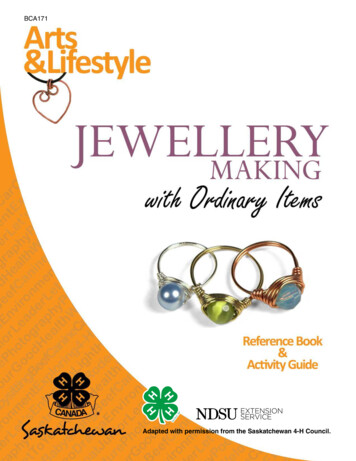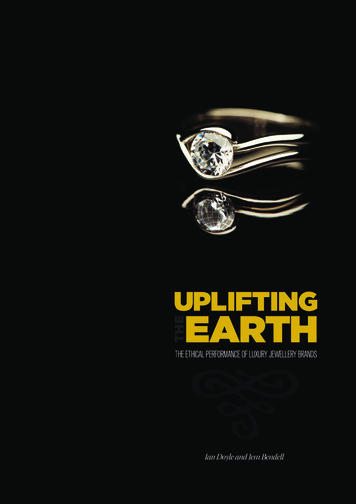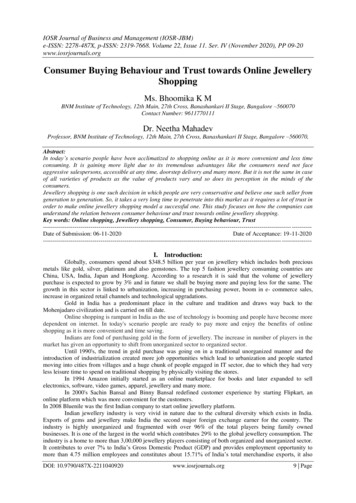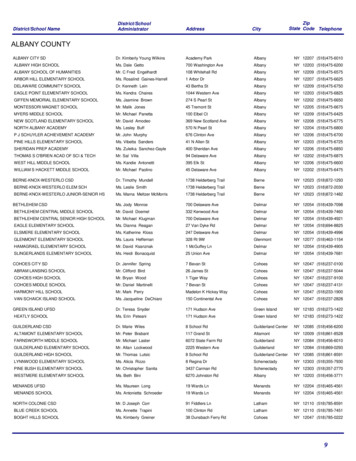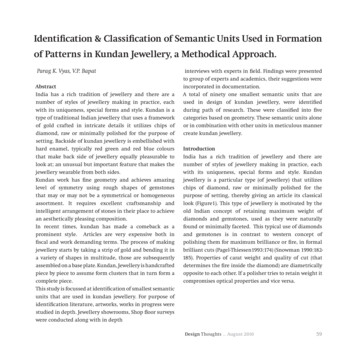
Transcription
Identification & Classification of Semantic Units Used in Formationof Patterns in Kundan Jewellery, a Methodical Approach.Parag K. Vyas, V.P. BapatAbstractIndia has a rich tradition of jewellery and there are anumber of styles of jewellery making in practice, eachwith its uniqueness, special forms and style. Kundan is atype of traditional Indian jewellery that uses a frameworkof gold crafted in intricate details it utilizes chips ofdiamond, raw or minimally polished for the purpose ofsetting. Backside of kundan jewellery is embellished withhard enamel, typically red green and red blue coloursthat make back side of jewellery equally pleasurable tolook at; an unusual but important feature that makes thejewellery wearable from both sides.Kundan work has fine geometry and achieves amazinglevel of symmetry using rough shapes of gemstonesthat may or may not be a symmetrical or homogeneousassortment. It requires excellent craftsmanship andintelligent arrangement of stones in their place to achievean aesthetically pleasing composition.In recent times, kundan has made a comeback as aprominent style. Articles are very expensive both infiscal and work demanding terms. The process of makingjewellery starts by taking a strip of gold and bending it ina variety of shapes in multitude, those are subsequentlyassembled on a base plate. Kundan, Jewellery is handcraftedpiece by piece to assume form clusters that in turn form acomplete piece.This study is focussed at identification of smallest semanticunits that are used in kundan jewellery. For purpose ofidentification literature, artworks, works in progress werestudied in depth. Jewellery showrooms, Shop floor surveyswere conducted along with in depthinterviews with experts in field. Findings were presentedto group of experts and academics, their suggestions wereincorporated in documentation.A total of ninety one smallest semantic units that areused in design of kundan jewellery, were identifiedduring path of research. These were classified into fivecategories based on geometry. These semantic units aloneor in combination with other units in meticulous mannercreate kundan jewellery.IntroductionIndia has a rich tradition of jewellery and there arenumber of styles of jewellery making in practice, eachwith its uniqueness, special forms and style. Kundanjewellery is a particular type (of jewellery) that utilizeschips of diamond, raw or minimally polished for thepurpose of setting, thereby giving an article its classicallook (Figure1). This type of jewellery is motivated by theold Indian concept of retaining maximum weight ofdiamonds and gemstones, used as they were naturallyfound or minimally faceted. This typical use of diamondsand gemstones is in contrast to western concept ofpolishing them for maximum brilliance or fire, in formalbrilliant cuts (Pagel-Thiessen1993:174) (Snowman 1990:182185). Properties of carat weight and quality of cut (thatdetermines the fire inside the diamond) are diametricallyopposite to each other. If a polisher tries to retain weight itcompromises optical properties and vice versa.Design Thoughts August 201059
Figure1- Kundan as a style of settingKundan jewellery has a structural framework of goldcrafted in intricate details. The gemstone is set from thefront using a foil of very high purity gold foil. For thepurpose of setting a very thin foil is rolled in a mill, at suchfineness and low thickness gold becomes very pliable. Partsand pieces of this foil are pressed in cavities left aroundthe gemstone, partly set with setting paste. By pressinglayer after layer of gold, space around gemstone is slowlyfilled with solid gold, this pressing is done by a pointedtool that gives good pressure and negotiates tight cornersto get a flush stone close setting (Untracht 1985:614).Sometimes mild heat is applied to fuse gold together. Goldsurface holding gemstone in place is evened out usingan engraver that leaves behind a lustrous surface. Thismethod is also used to make gold patterns over a varietyof substrates like conch shell, ivory, precious and semiprecious gemstones like agate and marble. To achieve apattern as if gold is inlaid on surface, first pattern is tracedon surface. Thereafter holes are drilled in key locationsthat act as nodes and anchor points. These points are filledwith gold pins (or foils or both) that work as base60and anchor for successive gold work. Gold in form of foilsis worked on it and layers deposited to get desired shape.Excess gold is trimmed using engravers. Ultimately thesurface appears as gold is inlaid into it (Sharma, Varadrajan2008:111).Kundan work has a well-defined geometry and amazinglevel of symmetry are achieved using rough shapes thatmay not be uniform and symmetrical like round brilliantcuts. Work requires excellent craftsmanship and cleverarrangement of stones in their place to achieve anaesthetically pleasing composition. “Janchana” (Hindi,Guajarati- to make look beautiful) is a process of looking atcomposition before actual setting takes place. A Photostator tracing of design is taken and stone composition ischecked over this acting as background. There may beseveral trial and errors before a stone finds its right placeand orientation. Once the craftsman is satisfied with hisscheme of things, actual setting takes place.Backside of kundan jewellery is embellished with hardenamel typically red green and red blue colours. Thismakes back side of jewellery equally pleasurable to lookat a feature that makes jewellery wearable from bothsides, the backside may often be better than front(Sharma,Varadrajan 2008:21) Enamel also works as security featurefor settings which gets disturbed if a stone is taken out andset again with a lower carat or inferior quality stone.Need for researchKundan jewellery has made a comeback in recent yearsand re-established as a classical style. The work is intensiveboth in terms of efforts and material. There is a vacuumof methodical study in domain of kundan. Some materialwas available in the form of photographic documentationor in books on jewellery (Balakrishnan 2006:103-141).Other source for kundan was jewellers in possession ofmaterial either in form of designs or articles (ready andsemi finished) they were initially reserved in sharing theDesign Thoughts August 2010
same. This style of jewellery has a visual language of itsown but no cataloguing is available, to understand anddescribe, in a systematic manner.MethodologyResearch in domain of jewellery needed an approachdemanding delicacy and subtlety. Information andresources are not easily available and rather protected forthe fear of competition by other jewellers. This researchwas conducted by adopting proven research methodology,as suggested by researchers (Hair et al. 2005, Kothari2002) from time to time for different cases. In presentstudy, Jewellers and kundansaaz were approached forpreliminary learning. Each and every approachable personwas interviewed at length. These interviews were intendedfor following purposea) To understand the importance of kundan Jewellery inIndiab) Understand their essential visual features, their usagein Kundan and application in designIt took time, efforts and confidence building measuresto win their trust to have access to these resources. Theseinterviews helped in better understanding of subject fromprofessional’s point of view.For purpose of study, material from various sources wascollected and studied (Shajahan2004:137). Primary sourceswere photographs in books, photographs of articles,sketches and renderings by those practicing kundan.Study material from various sources were compiled andstudied in a methodical way by labelling individualsemantic units and tabulate them. This whole exercise ledto identification of a total of 99 basic semantic units alongwith their basic descriptions. These findings were validatedby series of experts (four Jewellers, five kundansaaz andfour designers) practicing kundan Jewellery. Finally 99unites were retained, while those found to be replicatingin terms of shape or not carrying unique design measures,were deleted. A chart of these semantic units was preparedas a foundation for further classification.Smallest Semantic UnitsJewellery has an overall form for any given article like ring,pendent, bracelet, neck piece or ear pieces. This overallform is a collection of sub assemblies as form clusters(Figure2). A Form clusters in turn is made of units thatare geometric or inspired by nature. These are “smallestsemantic units” elemental building blocks of jewellery,they are used alone or in combination with other suchunits an aesthetically pleasing composition to make a“form cluster”.Figure2. Kundan Necklace, smallest semantic units & formDesign Thoughts August 201061
Figure3- Progression from basic curves that make smallest semanticunits to a set of jewelleryA progression from basic curves that make smallestsemantic units to a set of jewellery comprising of variousarticles could be seen as Curves Smallest semantic units Form clusters Jewellery (overall form) Set of articles (following a theme)Illustration (Figure3) is to articulate length and breadthof research, which is from smallest semantic units tooverall jewellery form. Accordingly, Semantic unitsidentifiable by names are basic units of constructionof jewellery, if further divided into curves, meaning islost. Semantic units have their own symbolism and drawinspiration from nature, both plant and animal (Sharma,62Varadrajan 2008:10). In this study 99 smallest semanticunits are identified that were individually identifiableby their names like Koile, daudi paan and jau etc. Thesesmallest semantic units, by way of analogy of letters (andligatures) of alphabet, were used in combination withother semantic units to constitute form clusters (words),these in turn are used to form the article (sentences) andsets (paragraphs as, several coherent lines on a theme).(Jewellery articles, a neck piece, two bangles, a mangteekaand a pair ear rings constitute a basic set.Analysis (Tabulation)The semantic units were recognized by their names; itwas derived by their particular geometric shapes and usedin communication among kundanssaz community. Therational was based on resemblance to a known geometricDesign Thoughts August 2010
Figure4- Smallest Semantic Units identified by their namesDesign Thoughts August 201063
shape like polygon, closed curve or forms from nature likebirds, flowers and leaves.This identification of a smallest semantic unit with aname makes description and articulation of a design moreeffective, illustrated as follows (Figure4).Classification of Smallest Semantic UnitsA cataloguing provides a platform for further study thatacts as reference. This tabulation is a register from whichsemantic units are further classified into five categoriesfor ease of understanding.In diamond polishing industry, a manner of namingbased on appearance and resemblance to a known form(Figure5a&b) was followed in classification of fancybrilliant cut diamonds (Pagel-Thiessen1993:171-173).Drawing reference, this classification was based on basicgeometric shape or resemblance. These categories providea methodical way to look at them as a group followingsimilar geometric ideology (ibid 255-258).This method of classification was found suitable andadapted for classifying Semantic units used in kundanrelatively large category hence, further divided in four subcategories.Further fancy cuts of diamondsFishButterflyCrossStarFigure5a- Naming based on appearance and resemblanceFigure 5b- Naming based on appearance and resemblance64Design Thoughts August 2010Horse’s head
jewellery. Identified 99 semantic units were classifiedinto five broad categories. Category of sphenoid was arelatively large category hence, further divided in four subcategories.1. Two axis of symmetry- These smallest semantic unitshad two axis of symmetry that is they were symmetricaround two axes, vertical as well as horizontal. Conics(Circle& ellipses) and various uniform polygons fall in thiscategory. Forms that were made by replacing sides of aneven sided polygon by a modified curve also come underthis category.5. Conjoined–these semantic units were an assemblage ofmore than one individual unit, which acquire a meaningof their own and are treated as a smallest semantic unit.They had a full thought encompassed within themselves,reflecting in their name. Kamal, chidi and machhli aresuch semantic units. These semantic units by analogy,for purpose of understanding could be compared toSanyuktakshar or beej mantra (seed syllable) that is asyllable and a mantra within itself.2. One axis of symmetry- These smallest semantic units hadone axis of symmetry, either vertical or horizontal. Shapeslike Heart, club, spade, cup, half moon and polygons withunequal opposing sides fell in this category.3. Rotational symmetry- these smallest semantic unitswere made up of floral motifs that were having rotationalsymmetry (inversion around a point is visible). Indianswastika is a classical example of such an inversion, in thisstudy there was one such member kery chowfuliya.4. Sphenoid- These smallest semantic units were madeup of splines that follow shape of an alphabet (s,c &n) ora wing. Koilee, pankh, Phool and Phool kali constitutethis category. This is a large group that was furtherdivided into four sub categories as the name of alphabetsuggests S-shape, N-shape, C-shape and Fan shape. This subclassification was driven by the semblance of the shape ofalphabet and visual flow of smallest semantic unit.Design Thoughts August 201065
hokiA square, used in both vertical and slantconfigurationTwo axis of symmetry2Tikhi Choki /Shakkar paraA square with concave curve forming sharppointsTwo axis of symmetry3Austpel /AustpehalAn octagon with equal sides & chamferTwo axis of symmetry4Gole ChokyA square with liberal filletsTwo axis of symmetry5Lamba AustpelAn octagon with adjoining unequal but equalopposing sides & chamferTwo axis of symmetry6Tikha AustpelA trapezoidal octagon with two equal opposingsides other two long and shortOne axis of symmetry7GoleA circleTwo axis of symmetry8Oval / Nim goleAn ellipse or a pillow shape with major axisused verticallyTwo axis of symmetry9Tikha ChofuliyaA floral motif with four petals made of twoconcave curvatures meeting at a pointTwo axis of symmetry10Gole ChofuliyaA floral motif with four petalsTwo axis of symmetry11Gole chhakliyaA floral motif with five or more petals or clusterof petalsOne axis of symmetry12Heart/ DaudiA heart shape resembling a beetle leafOne axis of symmetry13Teda daudi panA heart shape with point tilted to one sideSphenoid - C Shape14Tikha DaudiPanA beetle leaf shape, skewed and compressed,also called teekha paanSphenoid - S Shape15Keri DaudiA shape with two pointed ends and a bulge inbetweenSphenoid - C Shape16Keri17Keri Dandi66A mango shape, a often used form in all majorstylesA mango shape, a often used form in all majorstyles, one point slightly elongated to resemblestem of fruitDesign Thoughts August 2010Sphenoid - C ShapeSphenoid - S Shape
18Kery ChofulA floral motif with four petals made of twoconcave curvatures meeting at a point andtilted in a directionRotational symmetry19Siru / bundA Drop or Pear Shape shaped like a pendeloqueOne axis of symmetry20Gole TrikonA triangle or trilobite made by replacing sidesof a triangle by an arc of a circleOne axis of symmetry21Tikha PyalaA cup shape resembling a goblet or chalice top,one point made of two concave curvesOne axis of symmetry22Daudi PyalaA cup shape roughly resembling a goblet orchalice top, slight skew to one sideSphenoid - C Shape23PyalaPattiA shape resembling a combination of a chaliceand a leafSphenoid - C Shape24Pyalapatti1A shape resembling a combination of a chaliceand a leaf, slender and skewed to a sideSphenoid - N Shape25Pyalapatti2A shape resembling a combination of a chaliceand a leaf, stylizedSphenoid - S Shape26Pyala patti3A shape resembling a combination of a chaliceand a leaf, elongated and skewed to a sideSphenoid - S Shape27Ful PyalaA cup shape resembling a goblet or chalicetop, one point made of two concave curves,asymmetric and skewedSphenoid - C Shape28ShankhalaA conch shape bulbous on top and pointed tobottomOne axis of symmetry29Shankh FulA conch like spiral shape growing outwardsSphenoid - C Shape30ChhiplaA shape resembling a lobe of pearl oysterSphenoid - S Shape31Chhipla1A shape resembling a skewed lobe of pearloysterSphenoid - S Shape32Chhipla2A shape resembling a lobe of pearl oyster witha depression on one sideSphenoid - N Shape33ChandA Half moon shape like a sickle bladeOne axis of symmetry34Teda ChandA skewed half moon shapeSphenoid - C Shape35Chidi1An abstract bird in flight shapeSphenoid - S Shape36Chidi2An abstract bird in flight shape, elongatedSphenoid - S ShapeDesign Thoughts August 201067
37Chidi3An abstract bird in flight shape, steep skewverticallySphenoid - S Shape38Shiru panA leaf shape sans vein, made of skewed dropSphenoid - C Shape39PankhA wing shape with detail cuts depicting individualfeathersSphenoid - Fan Shape40JauA shape resembling wheat or barley seed made oftwo arcs of a circleTwo axis of symmetry41KoyaliA shape resembling leaf made of two sinewy curvesSphenoid - S Shape42Koyali1A shape resembling leaf made of two sinewycurves, with a slight bulge on one sideSphenoid - N Shape43Lamb KoyaliA shape resembling leaf made of two sinewy curves,with a lean appearanceSphenoid - N Shape44Koyali dandiA stylized koyali with a taper towards top, heavybottomSphenoid - N Shape45Dand KoyaliA stylized koyali with a taper towards top, heavybottom, one point slightly elongated to resemblestemSphenoid - N Shape46Koyali MindiA stylized koyali with point slightly elongated toresemble stem terminating in one circle calledmindiSphenoid - N Shape47Gole KoyaliA stylized koyali with a prominent bulge toaccommodate large stonesSphenoid - N Shape48Daudi KoyaliA stylized koyali with partial features of daudipaanSphenoid - N Shape49Koyali KhachgoleA stylized koyali with a prominent bulge toaccommodate large stones and a notch to one sideSphenoid - N Shape50Khanch Koyali1A stylized koyali with a notch to one sideSphenoid - N Shape51Khach koyali2A stylized koyali with slender appearance and anotch to one sideSphenoid - S Shape52Khach koyali3A stylized koyali with partial features of daudipaan with a prominent s shapeSphenoid - S Shape53gole koyalidandiA stylized koyali with a mindi fused in bodySphenoid - S Shape54Ti-Koyali mindiA stylized koyali with three prominent apexshowing in one with a mindi fused in body shapeSphenoid - C Shape68Design Thoughts August 2010
55Ti-koyaliA stylized koyali with three prominent apex showingin one shapeSphenoid - C Shape56Koyali PankhA stylized koyali with three prominent apex showingin one with a mindi fused in end, fan like appearenceSphenoid - S Shape57Koyali pankh2A stylized koyali with two prominent apex showing inone shape with fan like appearenceSphenoid - Fan Shape58Koyali PattipyalaA chalice shape with three prominent apex, sharingpartial features of a koyali and and a pattiSphenoid - C Shape59Koyali fulA flower shape composed from a combination ofkoyaliesConjoined60MirchiA shape resembling a chilli pod stylized like aSphenoid - C Shape61KalliA shape resembling a flower bud just openingSphenoid - S Shape62kaliipattiA shape resembling a flower bud with partialfeatures of a leafSphenoid - S Shape63Dandi KalliA shape resembling a flower bud with end stylizedand elongated to resemble stemSphenoid - C Shape64patti dandiA leaf shape with end stylized and elongated toresemble stemSphenoid - S Shape65fulpattiA shape resembling a flower petal with partialfeatures of a leafSphenoid - S Shape66Fulpatti1A shape resembling a skewed flower petal withpartial features of a leafSphenoid - S Shape67Ful DandiA floral motif with two petals and one stylizedpoint elongated to resemble a budSphenoid - S Shape68Mindi JoA shape resembling wheat or barley seed withpartial features of koyli and mindiSphenoid - N Shape69bel pattiA leaf shape with a long and stylized stemSphenoid - N Shape70PandadiA leaf shape with a prominent bulge toaccommodate large stonesSphenoid - N Shape71Jasud pattiA shape like petal of a hibiscus flowerSphenoid - C Shape72golepattiA leaf shape with an apex and two lobesSphenoid - N Shape73PattiA shape resembling a broad leaf with a veinOne axis of symmetryDesign Thoughts August 201069
74Nim pattiA shape resembling a neem leaf with a veinand cutsSphenoid - C Shape75KamalA stylized lotus shape with five apexOne axis of symmetry76Adha FulFlower with three petals and one mindiOne axis of symmetry77Khach NakhiyaA shape like an animal nail with a depressionto one sideSphenoid - C Shape78NakhiyaA shape like an animal nail with a depressionto one side stylized like tiger clawSphenoid - C Shape79Parag rajA shape like stamen of a flowerSphenoid - C Shape80BatiA shape resembling a flame of a clay lampSphenoid - C Shape81BatakA bird shape resembling a duck or swanSphenoid - C Shape82MoreA stylized peacock motif made of paan, koelimindi and kaliConjoined83Chidi pattiA shape like a club in cards, with one lobehaving an apexConjoined84PattiA highly stylized leaf, opening like fern shootsConjoined85Panch patti fulA symmetrical flower with five pointed petalstop petal centrally placed with or without ahollow centreConjoined86Tikha chefulliyaA symmetrical flower with six pointed petalstop petal centrally placed with or without ahollow centreConjoined87PattiyaCluster of leaves usually three or moreConjoined88FulA highly stylized flower blossomingConjoined89Kamal pattiA lotus motif with or without stem and leavesConjoined90Ful pyalaA floral motif with two petals and lamba pyalaConjoined91MachhliA highly stylized fish motifSphenoid - N Shape70Design Thoughts August 2010
92Cut PattiA leaf cut from the sidesSphenoid - C Shape93Gole PyalaA cup shape resembling a goblet or chalicewith a round topSphenoid - C Shape94Mindi DandiA shape resembling a comma made of a mindiand a dandiSphenoid - C Shape95PatangA kite shape made of two convex and twoconcave archesOne axis of symmetry96Tikha PanA beetle leaf shape, skewed and compressed,with three apexSphenoid - N Shape97Mindi styleA stylized s mirrored and terminating into twomindi shapedSphenoid - N Shape98Ful KalliA flower and a bud shape stylized terminationConjoined99Gole Trikone1A triangle or trilobite with rounded cornersOne axis of symmetryTable1- smallest semantic units, description and classificationImplication of Research & ConclusionThis research provided besides a cataloguing, anunderstanding of semantic units that can be applied todesign as tabulated in (Table 1). There was no definite wayavailable to understand and articulate Semantic units. Thiscataloguing provides a basis for communication by makingknown, a part of, visual language of kundan. Used in formof a visual aid this can make communication easier andeffective between a jeweller and his clients.Future ResearchStudy further continues into domain to understand formclusters created by these semantic units. Their uniquenessand their interplay with each other create overall formof jewellery. The form clusters, using a mother circle aredeveloped as a research tool to gauge user preference.This study is expected to provide a way to mathematicallyinterpret design aspects, which have a positive influence onliking/ disliking of that article.DefinitionsForm cluster - Kundan work is made of smallest semanticunits used alone or in combination with others. Acompilation of semantic units in a certain mannerconstitute a cluster.Piece (or Article) - An article, like necklace, is made of formclusters (of semantic units) following a pattern and largelysame visual language. Pattern is formed by repetition orscaling or a variety of other devices. These elements makethe articles like the alphabet makes the words that in turnmake sentences and paragraphs.Design Thoughts August 201071
Set- A set is a compilation of various articles like ring,bangles, necklace etc. following same visual language.ReferencesUntracht Oppi, Jewelry Concepts And Technology, Doubleday &Company, Inc., Garden City New York, 1985Glossary of termsCarat- used in context of diamonds, refers to the measureof weight 200 milligrams. Used in context of gold refers toalloy composition in parts of 24. (Example, 22 carat gold isan alloy that has 22 parts gold and two parts of any otheralloy metal, usually silver or copper, per 24 parts of metalmixed weight by weight. They are abbreviated and referredto as ‘C’ and ‘k’ respectively in their individual contexts.Fire- used in context of diamonds, refers to the opticalproperty of total internal refraction.Pagal- Theisen Verena, Diamond Grading ABC Handbook ForDiamond Grading, Rubin & son bvba, Antwerp 1993Snowman A. Kenneth, The Master Jewelers, Thames and HudsonLtd., London, 1990Balakrishnan Usha R. & Kumar, Meera Sushil, Dance of the Peacock:Jewellery Traditions of India, India Book House Pvt. Ltd, 2004Balakrishnan Usha R. & Kumar, Meera Sushil, Jewels of the Nizam,India Book House Pvt. Ltd, 2006Stone- used in context of gemstones, usually diamond or aprecious/semi precious stone.Untracht Oppi, Traditional Jewellery of India, Thames And HudsonLtd., London 1997Brilliant cuts- used in context of diamonds, refers topolishing (cuts) with high (to very high) optical propertiesof total internal reflection in various shapes. (Round, oval,pillow, heart, teardrop etc)Sharma R. D.,Varadrajan M., Handcrafted in India, Lustre Press2008Shajahan S Dr., Research Methods for Management, JaicoKundan- The word kundan in Hindi means “Pure gold,” andis applied to a flush stone closed setting type commonlypracticed in India in the ancient past and still in use todayfor both cabochon and faceted stones.publishing house 2004Kundansaaz- A Jeweler who makes kundan articles,especially setting stones flush. Also call ed Karighar.Photograph & SourceDiamond Grading ABC, Handbook For Diamond GradingDance of the Peacock: Jewellery Traditions of IndiaJewels of The NizamCompilation of Design works – M. Panchal & Vinay S.72Design Thoughts August 2010
Kundan jewellery has made a comeback in recent years and re-established as a classical style. The work is intensive both in terms of efforts and material. There is a vacuum of methodical study in domain of kundan. Some material was available in the form of photographic documentation or in books o
